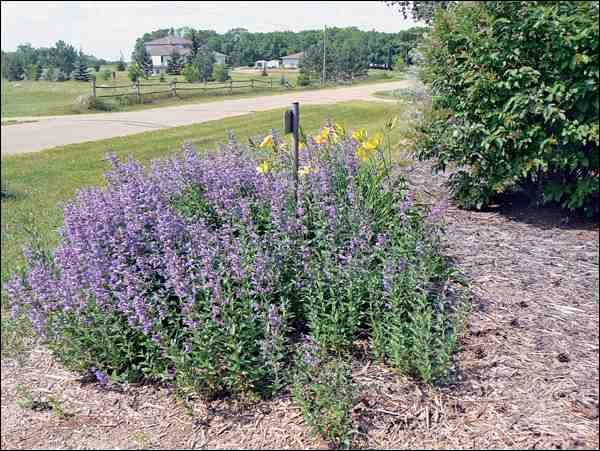Catmint, a hardy perennial, is an excellent addition to the fall garden being at its showiest now, in September.
As one would expect from the common name, catmints are members of the mint family. In fact the Latin genus name, Nepeta, means mint. Like all mints, they have square stems and opposite leaves (each leaf has a mate on the opposite side of the stem). Catmint foliage is generally a grey-green and emits a fragrance when crushed. Flowers can be blue, purple, mauve-pink or white. There are a number of species that comprise the catmint group and many of the named varieties are selections from individual species or interspecific hybrids.
Dropmore Blue is a cross of N. mussinii and N. ucranica introduced by Dr. Frank Skinner of Dropmore, Manitoba, in 1932. It is compact, 30 to 38 centimetres in height, with soft, scalloped, gray-green leaves and light purple flowers. Because it is sterile, it blooms almost the entire summer and does not reseed, nor is it invasive. It is used extensively in English rose gardens as edging.
Other cultivars include:
Six Hills Giant is 1 m (3 ft) in height, with dark blue flowers above grey foliage. It has not been widely tested but is worthy of trial.
Nepeta sibirica Blue Beauty (introduced as Souvenir d'Andre Chaudron by Skinner's Nursery in 1948) is about 60 centimetres (24 in.) tall. In addition it is very tough but a bit invasive; makes an excellent groundcover.
Walker's Low (N. racemosa) is named for a village, not its height, which is 40 centimetres (16 in.), with a spread of 60 centimetres (24 in.), making it a bit larger than Dropmore Blue. It has purplish blue flowers throughout the summer.
Nepeta grandiflora Dawn to Dusk form large plants up to 90 centimetres in height, with pink flowers.
Plant in full sun or partial shade on well-drained soil. Shear after flowering for a neater appearance. All do better on a leaner soil.
Nepeta Dropmore Blue is excellent as a border plant, as a companion to roses (for which it is used extensively in Great Britain), for edging, massing, and as a cut flower. It is a nectar source for bees. More aggressive catmints are best used for massing, naturalizing, in cottage gardens, or for stabilizing slopes. If you don't like cats, give a plant to your neighbor.
Catnip, another Nepeta species (N. cataria), is irresistible to most cats. After eating or smelling catnip, cats go crazy with chewing, licking, rolling around, pawing and purring in ecstasy. Some growl, meow, or salivate as though on a drug-induced high. What's responsible for this behavior is chemical compound in the plant tissue that may mimic a cat's sexual or territorial pheromones (a sort of feline come-hither "perfume.")
The active ingredient, nepetalactone, an aromatic oil, is detected through the cat's olfactory system by what is known as Jacobson's organ at the back of their nose. It must be inhaled to be effective. Although dramatic, the cats' response is generally limited to ten or 15 minutes, but may repeat itself after a few hours' lapse. Catnip has no harmful or long-term effects on cats, and some may become indifferent due to over-exposure - by which time your plant may be dead. Most kittens do not develop a response until at least three months of age. Older cats also appear less interested.
Catnip is more weedy appearing than their horticultural cousins and is usually only grown by cat lovers. Growing catnip can be a challenge with your own cat and all their frienemies in the neighbourhood eating, rolling on and otherwise damaging your catnip plants. Wire barriers and baskets may do the job but do little to enhance the beauty of one's flower borders. Inserting thorny sticks (such as rose, sea buckthorn, or raspberry canes) among the stems may be a less obvious but equally effective way of deterring unwanted felines.
Williams is the author of the new and revised Creating the Prairie Xeriscape. In her latest book, Saskatoon Forestry Farm Park & Zoo: A Photographic History, she tells of the history of an institution and the personal stories of the people who made an important impact on Prairie agriculture.
- This column is provided courtesy of the Saskatchewan Perennial Society (www.saskperennial.ca; [email protected]). Check out our Bulletin Board or Calendar for upcoming horticulture events: Labour&Learn at the Forestry Farm; Plant and Seed Exchange; fall bulb sales; tour; garden information sessions.




